Comprehensive Report: Primark's Business Environment and Stakeholders
VerifiedAdded on 2020/01/23
|16
|5365
|45
Report
AI Summary
This report provides a comprehensive analysis of Primark's business environment, examining its organizational structure, purpose, and stakeholder relationships. It delves into the company's responsibilities, including its interactions with employees, customers, and suppliers, and explores how Primark meets the objectives of each stakeholder group. The report further investigates different economic systems, focusing on the impact of fiscal and monetary policies on various sectors like farming and housing. It also analyzes market forces, pricing and output decisions, and the influence of business and cultural environments. Finally, the report assesses the impact of international trade and global factors, as well as the policies of the European Union, on UK business organizations, providing a holistic view of Primark's operations within the broader economic and political landscape.
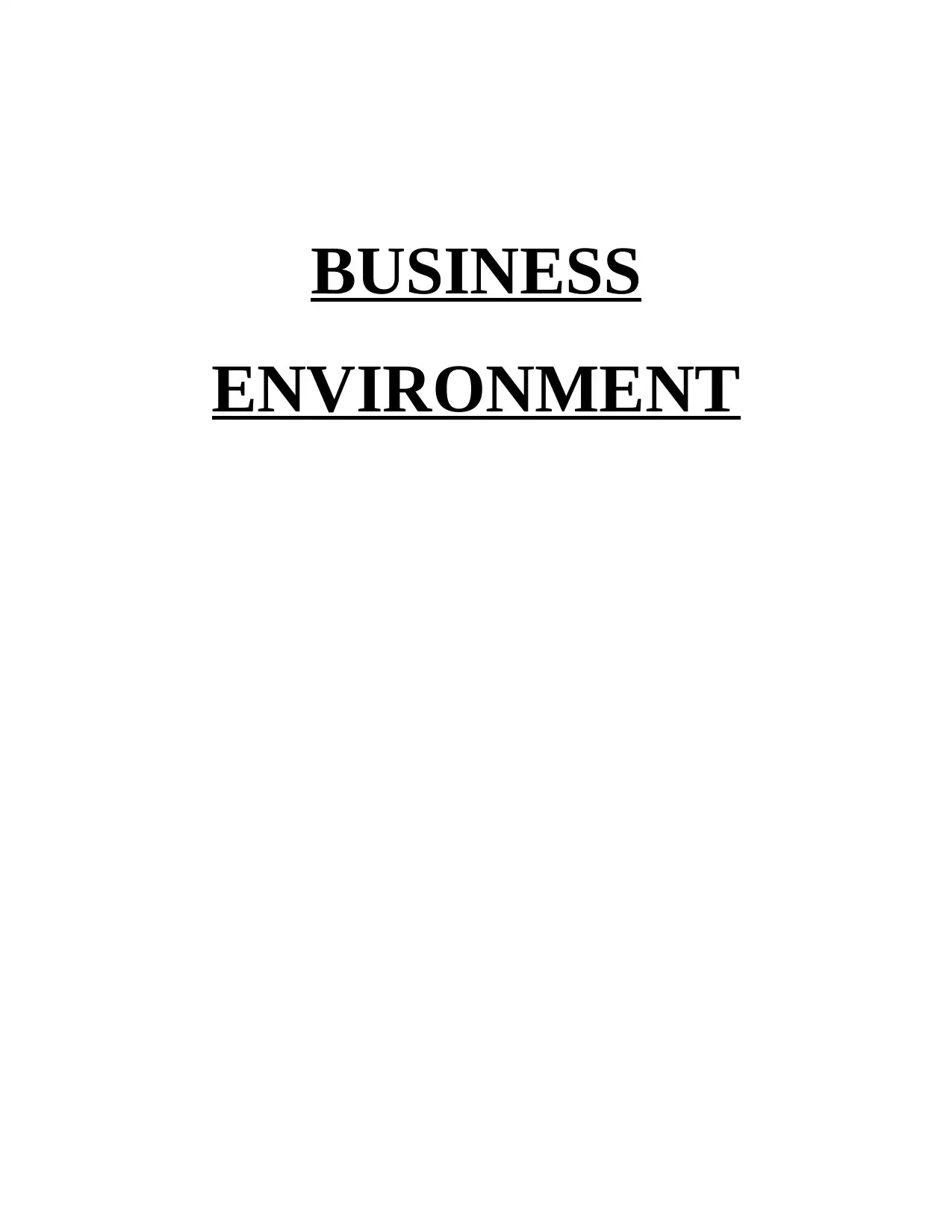
BUSINESS
ENVIRONMENT
ENVIRONMENT
Paraphrase This Document
Need a fresh take? Get an instant paraphrase of this document with our AI Paraphraser
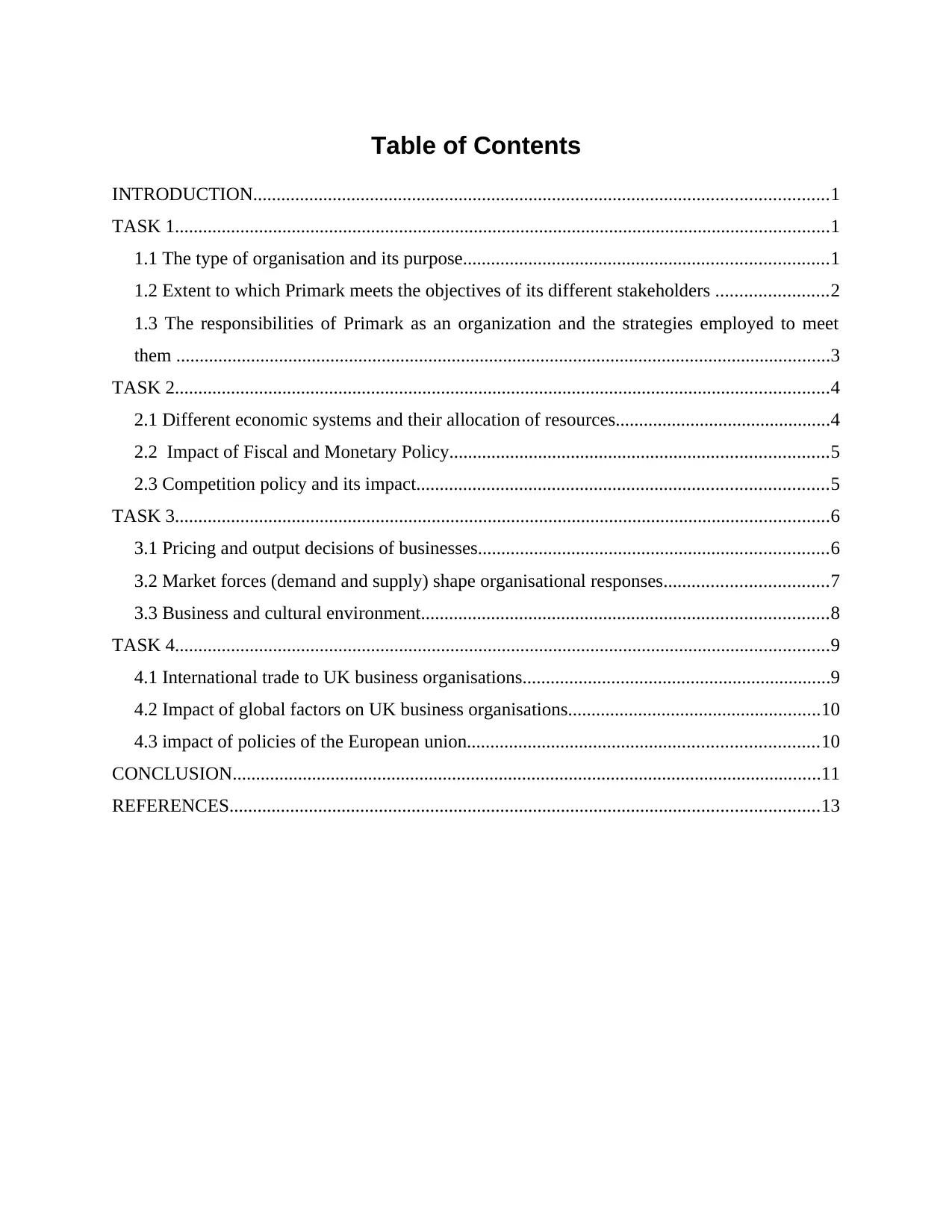
Table of Contents
INTRODUCTION...........................................................................................................................1
TASK 1............................................................................................................................................1
1.1 The type of organisation and its purpose..............................................................................1
1.2 Extent to which Primark meets the objectives of its different stakeholders ........................2
1.3 The responsibilities of Primark as an organization and the strategies employed to meet
them ............................................................................................................................................3
TASK 2............................................................................................................................................4
2.1 Different economic systems and their allocation of resources..............................................4
2.2 Impact of Fiscal and Monetary Policy.................................................................................5
2.3 Competition policy and its impact........................................................................................5
TASK 3............................................................................................................................................6
3.1 Pricing and output decisions of businesses...........................................................................6
3.2 Market forces (demand and supply) shape organisational responses...................................7
3.3 Business and cultural environment.......................................................................................8
TASK 4............................................................................................................................................9
4.1 International trade to UK business organisations..................................................................9
4.2 Impact of global factors on UK business organisations......................................................10
4.3 impact of policies of the European union...........................................................................10
CONCLUSION..............................................................................................................................11
REFERENCES..............................................................................................................................13
INTRODUCTION...........................................................................................................................1
TASK 1............................................................................................................................................1
1.1 The type of organisation and its purpose..............................................................................1
1.2 Extent to which Primark meets the objectives of its different stakeholders ........................2
1.3 The responsibilities of Primark as an organization and the strategies employed to meet
them ............................................................................................................................................3
TASK 2............................................................................................................................................4
2.1 Different economic systems and their allocation of resources..............................................4
2.2 Impact of Fiscal and Monetary Policy.................................................................................5
2.3 Competition policy and its impact........................................................................................5
TASK 3............................................................................................................................................6
3.1 Pricing and output decisions of businesses...........................................................................6
3.2 Market forces (demand and supply) shape organisational responses...................................7
3.3 Business and cultural environment.......................................................................................8
TASK 4............................................................................................................................................9
4.1 International trade to UK business organisations..................................................................9
4.2 Impact of global factors on UK business organisations......................................................10
4.3 impact of policies of the European union...........................................................................10
CONCLUSION..............................................................................................................................11
REFERENCES..............................................................................................................................13
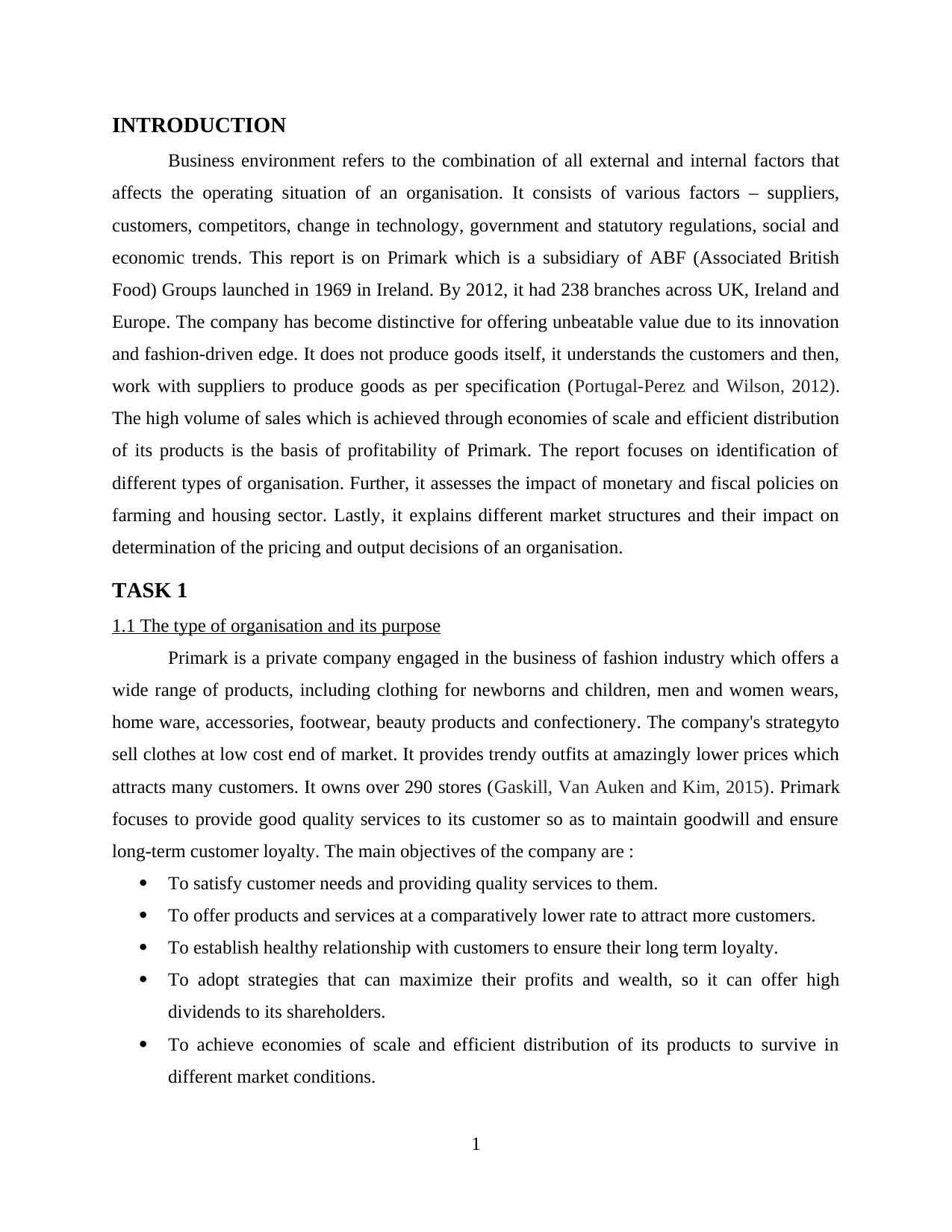
INTRODUCTION
Business environment refers to the combination of all external and internal factors that
affects the operating situation of an organisation. It consists of various factors – suppliers,
customers, competitors, change in technology, government and statutory regulations, social and
economic trends. This report is on Primark which is a subsidiary of ABF (Associated British
Food) Groups launched in 1969 in Ireland. By 2012, it had 238 branches across UK, Ireland and
Europe. The company has become distinctive for offering unbeatable value due to its innovation
and fashion-driven edge. It does not produce goods itself, it understands the customers and then,
work with suppliers to produce goods as per specification (Portugal-Perez and Wilson, 2012).
The high volume of sales which is achieved through economies of scale and efficient distribution
of its products is the basis of profitability of Primark. The report focuses on identification of
different types of organisation. Further, it assesses the impact of monetary and fiscal policies on
farming and housing sector. Lastly, it explains different market structures and their impact on
determination of the pricing and output decisions of an organisation.
TASK 1
1.1 The type of organisation and its purpose
Primark is a private company engaged in the business of fashion industry which offers a
wide range of products, including clothing for newborns and children, men and women wears,
home ware, accessories, footwear, beauty products and confectionery. The company's strategyto
sell clothes at low cost end of market. It provides trendy outfits at amazingly lower prices which
attracts many customers. It owns over 290 stores (Gaskill, Van Auken and Kim, 2015). Primark
focuses to provide good quality services to its customer so as to maintain goodwill and ensure
long-term customer loyalty. The main objectives of the company are :
To satisfy customer needs and providing quality services to them.
To offer products and services at a comparatively lower rate to attract more customers.
To establish healthy relationship with customers to ensure their long term loyalty.
To adopt strategies that can maximize their profits and wealth, so it can offer high
dividends to its shareholders.
To achieve economies of scale and efficient distribution of its products to survive in
different market conditions.
1
Business environment refers to the combination of all external and internal factors that
affects the operating situation of an organisation. It consists of various factors – suppliers,
customers, competitors, change in technology, government and statutory regulations, social and
economic trends. This report is on Primark which is a subsidiary of ABF (Associated British
Food) Groups launched in 1969 in Ireland. By 2012, it had 238 branches across UK, Ireland and
Europe. The company has become distinctive for offering unbeatable value due to its innovation
and fashion-driven edge. It does not produce goods itself, it understands the customers and then,
work with suppliers to produce goods as per specification (Portugal-Perez and Wilson, 2012).
The high volume of sales which is achieved through economies of scale and efficient distribution
of its products is the basis of profitability of Primark. The report focuses on identification of
different types of organisation. Further, it assesses the impact of monetary and fiscal policies on
farming and housing sector. Lastly, it explains different market structures and their impact on
determination of the pricing and output decisions of an organisation.
TASK 1
1.1 The type of organisation and its purpose
Primark is a private company engaged in the business of fashion industry which offers a
wide range of products, including clothing for newborns and children, men and women wears,
home ware, accessories, footwear, beauty products and confectionery. The company's strategyto
sell clothes at low cost end of market. It provides trendy outfits at amazingly lower prices which
attracts many customers. It owns over 290 stores (Gaskill, Van Auken and Kim, 2015). Primark
focuses to provide good quality services to its customer so as to maintain goodwill and ensure
long-term customer loyalty. The main objectives of the company are :
To satisfy customer needs and providing quality services to them.
To offer products and services at a comparatively lower rate to attract more customers.
To establish healthy relationship with customers to ensure their long term loyalty.
To adopt strategies that can maximize their profits and wealth, so it can offer high
dividends to its shareholders.
To achieve economies of scale and efficient distribution of its products to survive in
different market conditions.
1
⊘ This is a preview!⊘
Do you want full access?
Subscribe today to unlock all pages.

Trusted by 1+ million students worldwide
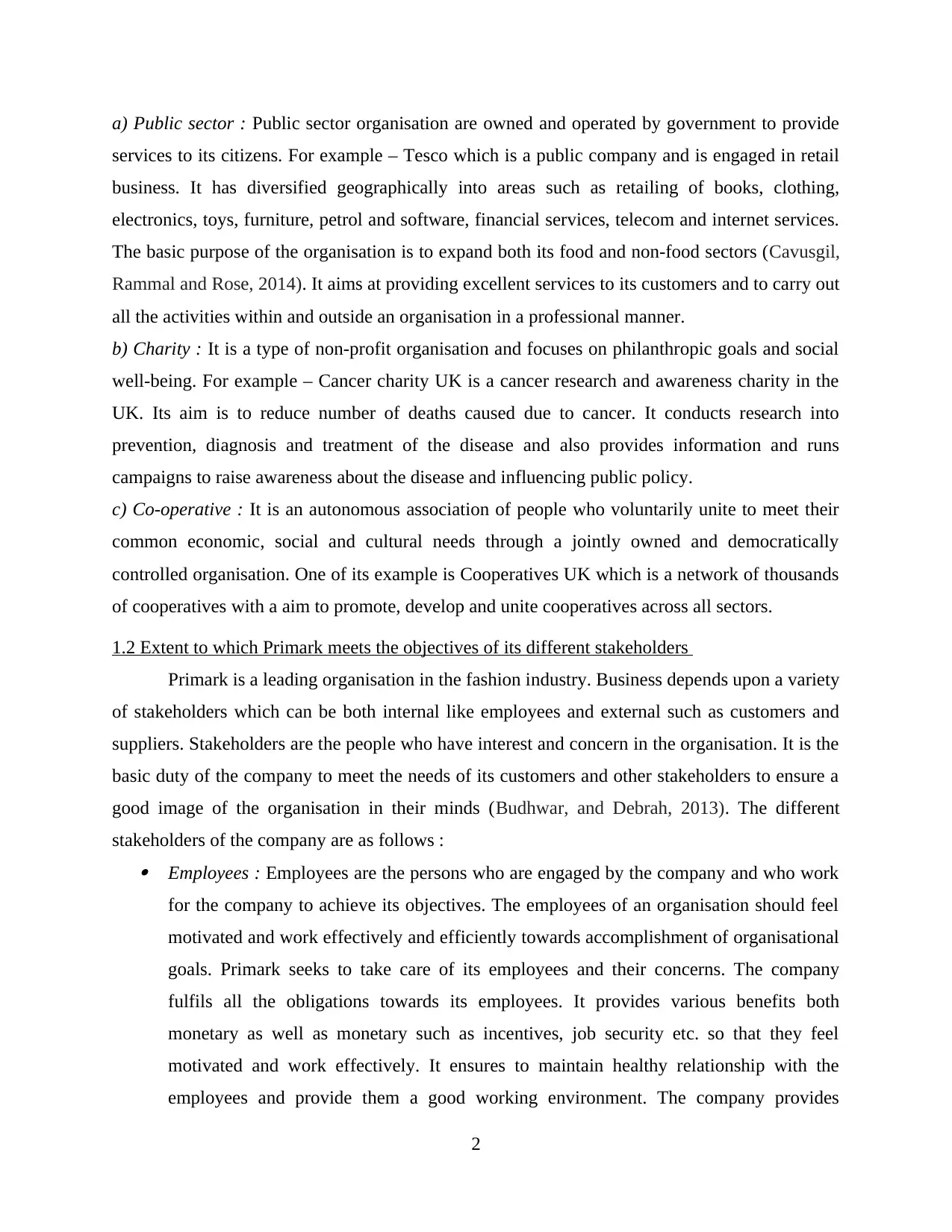
a) Public sector : Public sector organisation are owned and operated by government to provide
services to its citizens. For example – Tesco which is a public company and is engaged in retail
business. It has diversified geographically into areas such as retailing of books, clothing,
electronics, toys, furniture, petrol and software, financial services, telecom and internet services.
The basic purpose of the organisation is to expand both its food and non-food sectors (Cavusgil,
Rammal and Rose, 2014). It aims at providing excellent services to its customers and to carry out
all the activities within and outside an organisation in a professional manner.
b) Charity : It is a type of non-profit organisation and focuses on philanthropic goals and social
well-being. For example – Cancer charity UK is a cancer research and awareness charity in the
UK. Its aim is to reduce number of deaths caused due to cancer. It conducts research into
prevention, diagnosis and treatment of the disease and also provides information and runs
campaigns to raise awareness about the disease and influencing public policy.
c) Co-operative : It is an autonomous association of people who voluntarily unite to meet their
common economic, social and cultural needs through a jointly owned and democratically
controlled organisation. One of its example is Cooperatives UK which is a network of thousands
of cooperatives with a aim to promote, develop and unite cooperatives across all sectors.
1.2 Extent to which Primark meets the objectives of its different stakeholders
Primark is a leading organisation in the fashion industry. Business depends upon a variety
of stakeholders which can be both internal like employees and external such as customers and
suppliers. Stakeholders are the people who have interest and concern in the organisation. It is the
basic duty of the company to meet the needs of its customers and other stakeholders to ensure a
good image of the organisation in their minds (Budhwar, and Debrah, 2013). The different
stakeholders of the company are as follows : Employees : Employees are the persons who are engaged by the company and who work
for the company to achieve its objectives. The employees of an organisation should feel
motivated and work effectively and efficiently towards accomplishment of organisational
goals. Primark seeks to take care of its employees and their concerns. The company
fulfils all the obligations towards its employees. It provides various benefits both
monetary as well as monetary such as incentives, job security etc. so that they feel
motivated and work effectively. It ensures to maintain healthy relationship with the
employees and provide them a good working environment. The company provides
2
services to its citizens. For example – Tesco which is a public company and is engaged in retail
business. It has diversified geographically into areas such as retailing of books, clothing,
electronics, toys, furniture, petrol and software, financial services, telecom and internet services.
The basic purpose of the organisation is to expand both its food and non-food sectors (Cavusgil,
Rammal and Rose, 2014). It aims at providing excellent services to its customers and to carry out
all the activities within and outside an organisation in a professional manner.
b) Charity : It is a type of non-profit organisation and focuses on philanthropic goals and social
well-being. For example – Cancer charity UK is a cancer research and awareness charity in the
UK. Its aim is to reduce number of deaths caused due to cancer. It conducts research into
prevention, diagnosis and treatment of the disease and also provides information and runs
campaigns to raise awareness about the disease and influencing public policy.
c) Co-operative : It is an autonomous association of people who voluntarily unite to meet their
common economic, social and cultural needs through a jointly owned and democratically
controlled organisation. One of its example is Cooperatives UK which is a network of thousands
of cooperatives with a aim to promote, develop and unite cooperatives across all sectors.
1.2 Extent to which Primark meets the objectives of its different stakeholders
Primark is a leading organisation in the fashion industry. Business depends upon a variety
of stakeholders which can be both internal like employees and external such as customers and
suppliers. Stakeholders are the people who have interest and concern in the organisation. It is the
basic duty of the company to meet the needs of its customers and other stakeholders to ensure a
good image of the organisation in their minds (Budhwar, and Debrah, 2013). The different
stakeholders of the company are as follows : Employees : Employees are the persons who are engaged by the company and who work
for the company to achieve its objectives. The employees of an organisation should feel
motivated and work effectively and efficiently towards accomplishment of organisational
goals. Primark seeks to take care of its employees and their concerns. The company
fulfils all the obligations towards its employees. It provides various benefits both
monetary as well as monetary such as incentives, job security etc. so that they feel
motivated and work effectively. It ensures to maintain healthy relationship with the
employees and provide them a good working environment. The company provides
2
Paraphrase This Document
Need a fresh take? Get an instant paraphrase of this document with our AI Paraphraser
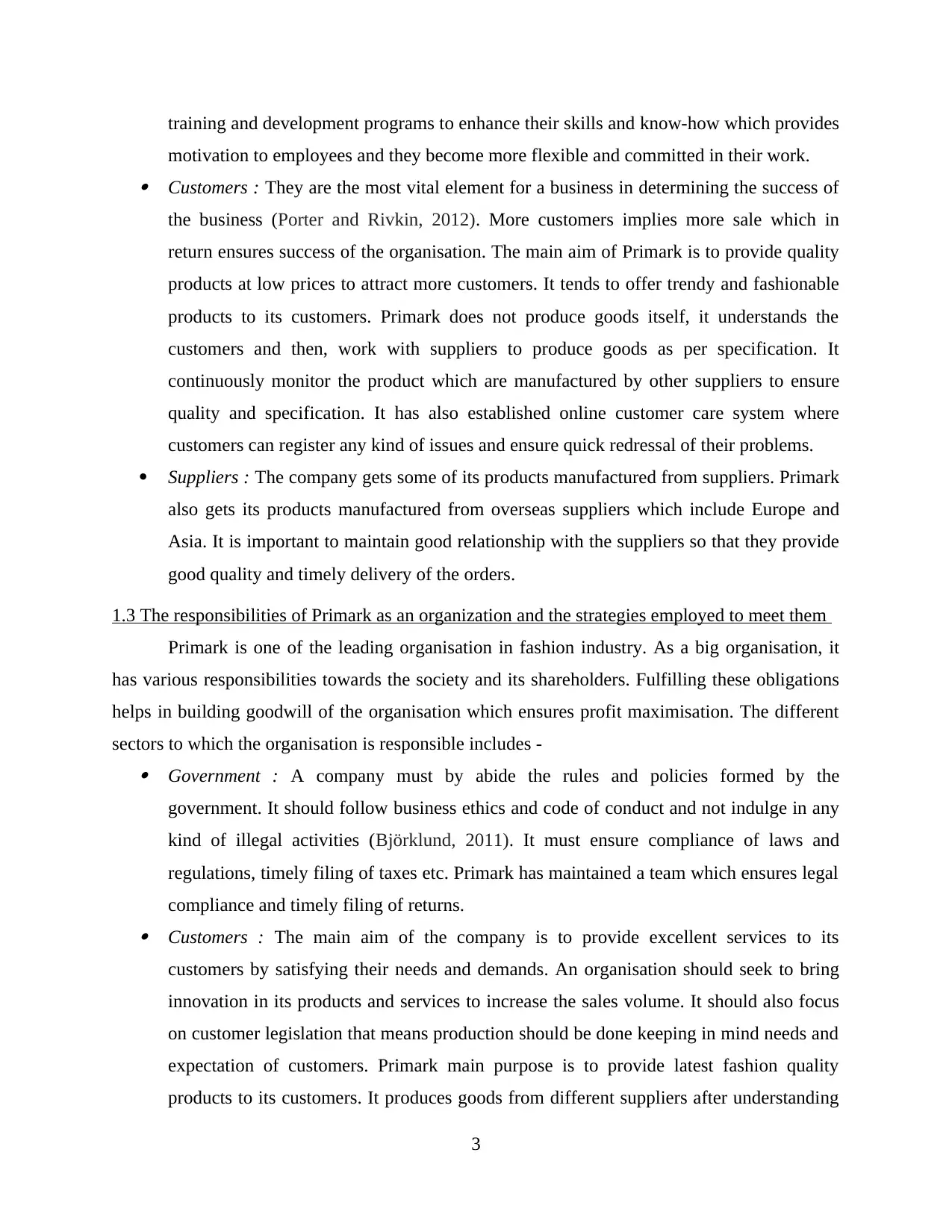
training and development programs to enhance their skills and know-how which provides
motivation to employees and they become more flexible and committed in their work. Customers : They are the most vital element for a business in determining the success of
the business (Porter and Rivkin, 2012). More customers implies more sale which in
return ensures success of the organisation. The main aim of Primark is to provide quality
products at low prices to attract more customers. It tends to offer trendy and fashionable
products to its customers. Primark does not produce goods itself, it understands the
customers and then, work with suppliers to produce goods as per specification. It
continuously monitor the product which are manufactured by other suppliers to ensure
quality and specification. It has also established online customer care system where
customers can register any kind of issues and ensure quick redressal of their problems.
Suppliers : The company gets some of its products manufactured from suppliers. Primark
also gets its products manufactured from overseas suppliers which include Europe and
Asia. It is important to maintain good relationship with the suppliers so that they provide
good quality and timely delivery of the orders.
1.3 The responsibilities of Primark as an organization and the strategies employed to meet them
Primark is one of the leading organisation in fashion industry. As a big organisation, it
has various responsibilities towards the society and its shareholders. Fulfilling these obligations
helps in building goodwill of the organisation which ensures profit maximisation. The different
sectors to which the organisation is responsible includes - Government : A company must by abide the rules and policies formed by the
government. It should follow business ethics and code of conduct and not indulge in any
kind of illegal activities (Björklund, 2011). It must ensure compliance of laws and
regulations, timely filing of taxes etc. Primark has maintained a team which ensures legal
compliance and timely filing of returns. Customers : The main aim of the company is to provide excellent services to its
customers by satisfying their needs and demands. An organisation should seek to bring
innovation in its products and services to increase the sales volume. It should also focus
on customer legislation that means production should be done keeping in mind needs and
expectation of customers. Primark main purpose is to provide latest fashion quality
products to its customers. It produces goods from different suppliers after understanding
3
motivation to employees and they become more flexible and committed in their work. Customers : They are the most vital element for a business in determining the success of
the business (Porter and Rivkin, 2012). More customers implies more sale which in
return ensures success of the organisation. The main aim of Primark is to provide quality
products at low prices to attract more customers. It tends to offer trendy and fashionable
products to its customers. Primark does not produce goods itself, it understands the
customers and then, work with suppliers to produce goods as per specification. It
continuously monitor the product which are manufactured by other suppliers to ensure
quality and specification. It has also established online customer care system where
customers can register any kind of issues and ensure quick redressal of their problems.
Suppliers : The company gets some of its products manufactured from suppliers. Primark
also gets its products manufactured from overseas suppliers which include Europe and
Asia. It is important to maintain good relationship with the suppliers so that they provide
good quality and timely delivery of the orders.
1.3 The responsibilities of Primark as an organization and the strategies employed to meet them
Primark is one of the leading organisation in fashion industry. As a big organisation, it
has various responsibilities towards the society and its shareholders. Fulfilling these obligations
helps in building goodwill of the organisation which ensures profit maximisation. The different
sectors to which the organisation is responsible includes - Government : A company must by abide the rules and policies formed by the
government. It should follow business ethics and code of conduct and not indulge in any
kind of illegal activities (Björklund, 2011). It must ensure compliance of laws and
regulations, timely filing of taxes etc. Primark has maintained a team which ensures legal
compliance and timely filing of returns. Customers : The main aim of the company is to provide excellent services to its
customers by satisfying their needs and demands. An organisation should seek to bring
innovation in its products and services to increase the sales volume. It should also focus
on customer legislation that means production should be done keeping in mind needs and
expectation of customers. Primark main purpose is to provide latest fashion quality
products to its customers. It produces goods from different suppliers after understanding
3
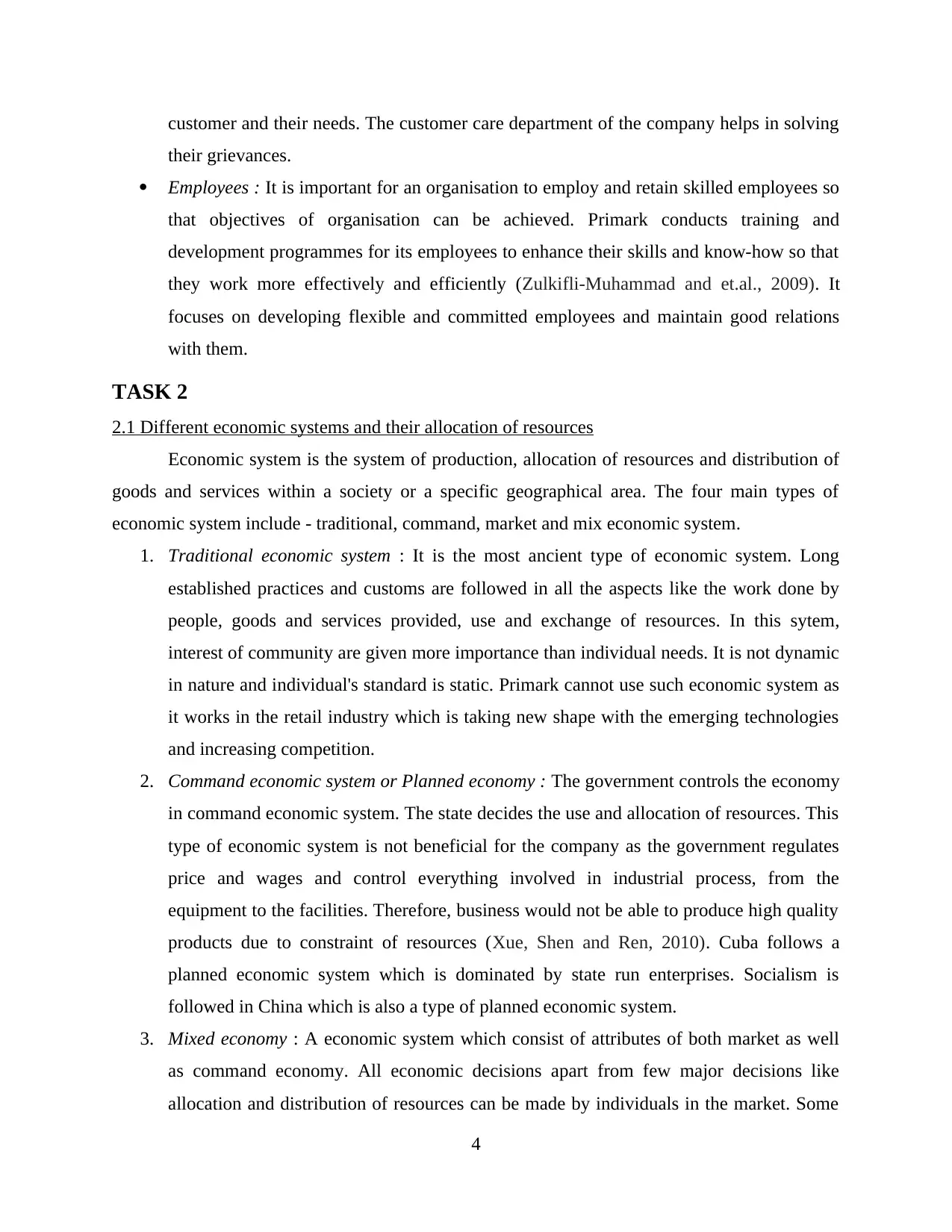
customer and their needs. The customer care department of the company helps in solving
their grievances.
Employees : It is important for an organisation to employ and retain skilled employees so
that objectives of organisation can be achieved. Primark conducts training and
development programmes for its employees to enhance their skills and know-how so that
they work more effectively and efficiently (Zulkifli-Muhammad and et.al., 2009). It
focuses on developing flexible and committed employees and maintain good relations
with them.
TASK 2
2.1 Different economic systems and their allocation of resources
Economic system is the system of production, allocation of resources and distribution of
goods and services within a society or a specific geographical area. The four main types of
economic system include - traditional, command, market and mix economic system.
1. Traditional economic system : It is the most ancient type of economic system. Long
established practices and customs are followed in all the aspects like the work done by
people, goods and services provided, use and exchange of resources. In this sytem,
interest of community are given more importance than individual needs. It is not dynamic
in nature and individual's standard is static. Primark cannot use such economic system as
it works in the retail industry which is taking new shape with the emerging technologies
and increasing competition.
2. Command economic system or Planned economy : The government controls the economy
in command economic system. The state decides the use and allocation of resources. This
type of economic system is not beneficial for the company as the government regulates
price and wages and control everything involved in industrial process, from the
equipment to the facilities. Therefore, business would not be able to produce high quality
products due to constraint of resources (Xue, Shen and Ren, 2010). Cuba follows a
planned economic system which is dominated by state run enterprises. Socialism is
followed in China which is also a type of planned economic system.
3. Mixed economy : A economic system which consist of attributes of both market as well
as command economy. All economic decisions apart from few major decisions like
allocation and distribution of resources can be made by individuals in the market. Some
4
their grievances.
Employees : It is important for an organisation to employ and retain skilled employees so
that objectives of organisation can be achieved. Primark conducts training and
development programmes for its employees to enhance their skills and know-how so that
they work more effectively and efficiently (Zulkifli-Muhammad and et.al., 2009). It
focuses on developing flexible and committed employees and maintain good relations
with them.
TASK 2
2.1 Different economic systems and their allocation of resources
Economic system is the system of production, allocation of resources and distribution of
goods and services within a society or a specific geographical area. The four main types of
economic system include - traditional, command, market and mix economic system.
1. Traditional economic system : It is the most ancient type of economic system. Long
established practices and customs are followed in all the aspects like the work done by
people, goods and services provided, use and exchange of resources. In this sytem,
interest of community are given more importance than individual needs. It is not dynamic
in nature and individual's standard is static. Primark cannot use such economic system as
it works in the retail industry which is taking new shape with the emerging technologies
and increasing competition.
2. Command economic system or Planned economy : The government controls the economy
in command economic system. The state decides the use and allocation of resources. This
type of economic system is not beneficial for the company as the government regulates
price and wages and control everything involved in industrial process, from the
equipment to the facilities. Therefore, business would not be able to produce high quality
products due to constraint of resources (Xue, Shen and Ren, 2010). Cuba follows a
planned economic system which is dominated by state run enterprises. Socialism is
followed in China which is also a type of planned economic system.
3. Mixed economy : A economic system which consist of attributes of both market as well
as command economy. All economic decisions apart from few major decisions like
allocation and distribution of resources can be made by individuals in the market. Some
4
⊘ This is a preview!⊘
Do you want full access?
Subscribe today to unlock all pages.

Trusted by 1+ million students worldwide
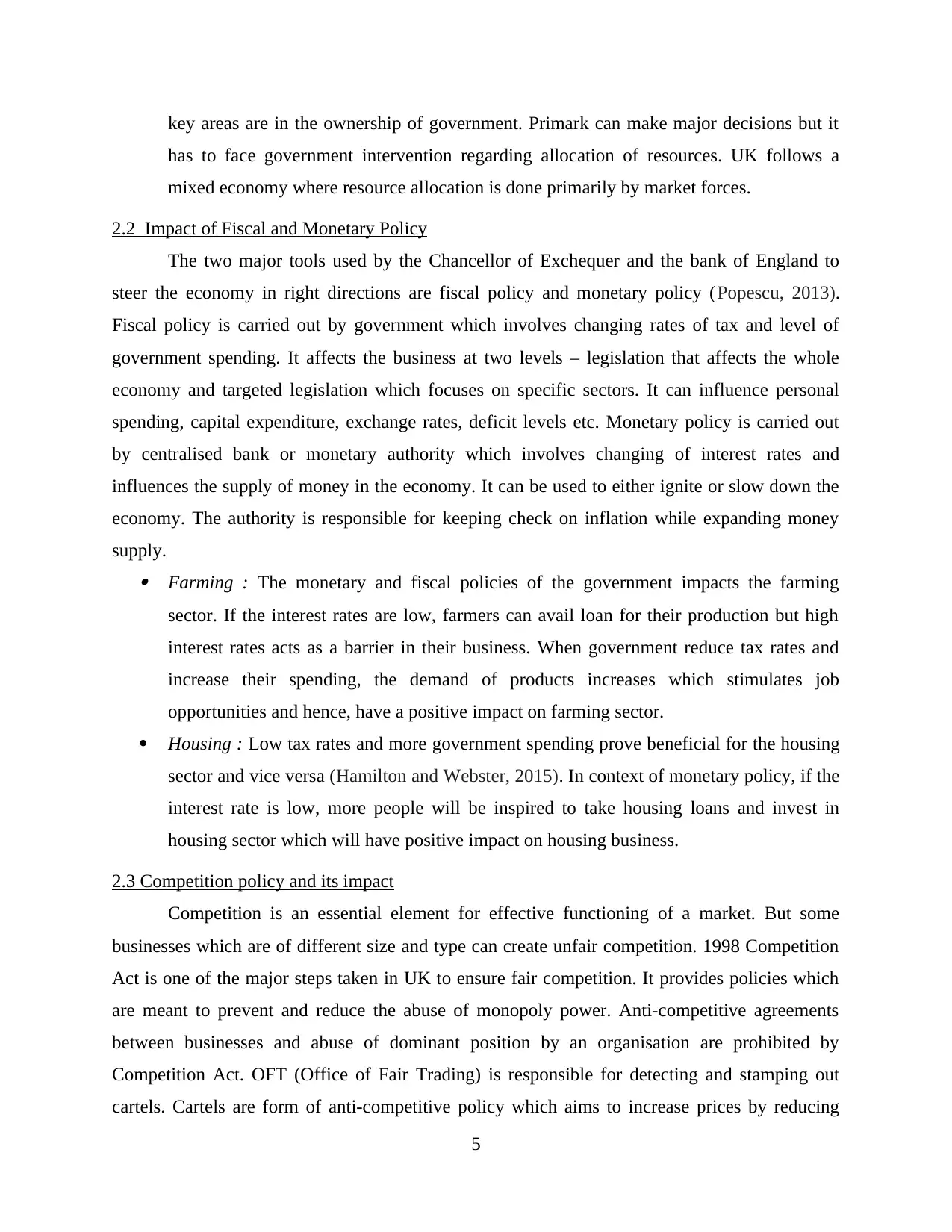
key areas are in the ownership of government. Primark can make major decisions but it
has to face government intervention regarding allocation of resources. UK follows a
mixed economy where resource allocation is done primarily by market forces.
2.2 Impact of Fiscal and Monetary Policy
The two major tools used by the Chancellor of Exchequer and the bank of England to
steer the economy in right directions are fiscal policy and monetary policy (Popescu, 2013).
Fiscal policy is carried out by government which involves changing rates of tax and level of
government spending. It affects the business at two levels – legislation that affects the whole
economy and targeted legislation which focuses on specific sectors. It can influence personal
spending, capital expenditure, exchange rates, deficit levels etc. Monetary policy is carried out
by centralised bank or monetary authority which involves changing of interest rates and
influences the supply of money in the economy. It can be used to either ignite or slow down the
economy. The authority is responsible for keeping check on inflation while expanding money
supply. Farming : The monetary and fiscal policies of the government impacts the farming
sector. If the interest rates are low, farmers can avail loan for their production but high
interest rates acts as a barrier in their business. When government reduce tax rates and
increase their spending, the demand of products increases which stimulates job
opportunities and hence, have a positive impact on farming sector.
Housing : Low tax rates and more government spending prove beneficial for the housing
sector and vice versa (Hamilton and Webster, 2015). In context of monetary policy, if the
interest rate is low, more people will be inspired to take housing loans and invest in
housing sector which will have positive impact on housing business.
2.3 Competition policy and its impact
Competition is an essential element for effective functioning of a market. But some
businesses which are of different size and type can create unfair competition. 1998 Competition
Act is one of the major steps taken in UK to ensure fair competition. It provides policies which
are meant to prevent and reduce the abuse of monopoly power. Anti-competitive agreements
between businesses and abuse of dominant position by an organisation are prohibited by
Competition Act. OFT (Office of Fair Trading) is responsible for detecting and stamping out
cartels. Cartels are form of anti-competitive policy which aims to increase prices by reducing
5
has to face government intervention regarding allocation of resources. UK follows a
mixed economy where resource allocation is done primarily by market forces.
2.2 Impact of Fiscal and Monetary Policy
The two major tools used by the Chancellor of Exchequer and the bank of England to
steer the economy in right directions are fiscal policy and monetary policy (Popescu, 2013).
Fiscal policy is carried out by government which involves changing rates of tax and level of
government spending. It affects the business at two levels – legislation that affects the whole
economy and targeted legislation which focuses on specific sectors. It can influence personal
spending, capital expenditure, exchange rates, deficit levels etc. Monetary policy is carried out
by centralised bank or monetary authority which involves changing of interest rates and
influences the supply of money in the economy. It can be used to either ignite or slow down the
economy. The authority is responsible for keeping check on inflation while expanding money
supply. Farming : The monetary and fiscal policies of the government impacts the farming
sector. If the interest rates are low, farmers can avail loan for their production but high
interest rates acts as a barrier in their business. When government reduce tax rates and
increase their spending, the demand of products increases which stimulates job
opportunities and hence, have a positive impact on farming sector.
Housing : Low tax rates and more government spending prove beneficial for the housing
sector and vice versa (Hamilton and Webster, 2015). In context of monetary policy, if the
interest rate is low, more people will be inspired to take housing loans and invest in
housing sector which will have positive impact on housing business.
2.3 Competition policy and its impact
Competition is an essential element for effective functioning of a market. But some
businesses which are of different size and type can create unfair competition. 1998 Competition
Act is one of the major steps taken in UK to ensure fair competition. It provides policies which
are meant to prevent and reduce the abuse of monopoly power. Anti-competitive agreements
between businesses and abuse of dominant position by an organisation are prohibited by
Competition Act. OFT (Office of Fair Trading) is responsible for detecting and stamping out
cartels. Cartels are form of anti-competitive policy which aims to increase prices by reducing
5
Paraphrase This Document
Need a fresh take? Get an instant paraphrase of this document with our AI Paraphraser
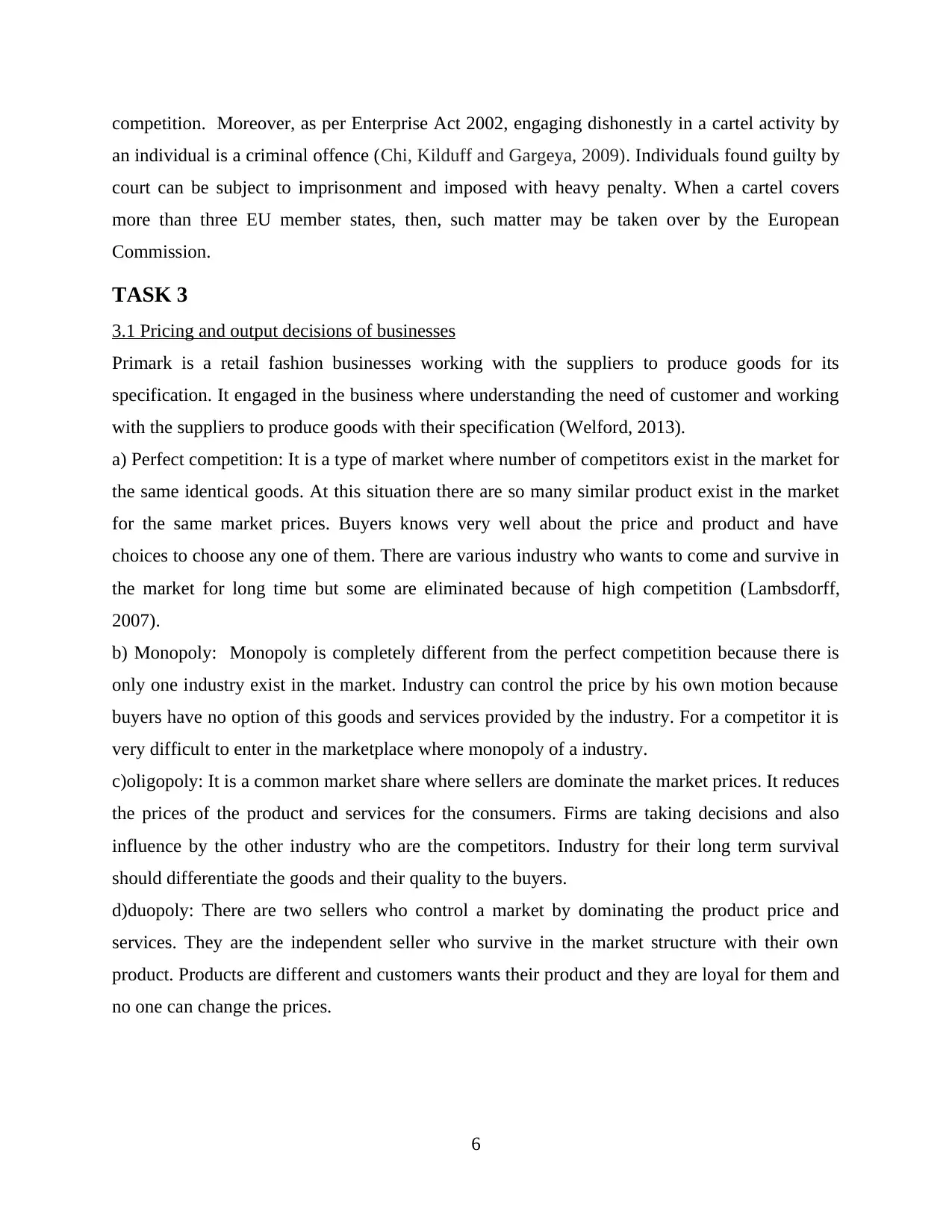
competition. Moreover, as per Enterprise Act 2002, engaging dishonestly in a cartel activity by
an individual is a criminal offence (Chi, Kilduff and Gargeya, 2009). Individuals found guilty by
court can be subject to imprisonment and imposed with heavy penalty. When a cartel covers
more than three EU member states, then, such matter may be taken over by the European
Commission.
TASK 3
3.1 Pricing and output decisions of businesses
Primark is a retail fashion businesses working with the suppliers to produce goods for its
specification. It engaged in the business where understanding the need of customer and working
with the suppliers to produce goods with their specification (Welford, 2013).
a) Perfect competition: It is a type of market where number of competitors exist in the market for
the same identical goods. At this situation there are so many similar product exist in the market
for the same market prices. Buyers knows very well about the price and product and have
choices to choose any one of them. There are various industry who wants to come and survive in
the market for long time but some are eliminated because of high competition (Lambsdorff,
2007).
b) Monopoly: Monopoly is completely different from the perfect competition because there is
only one industry exist in the market. Industry can control the price by his own motion because
buyers have no option of this goods and services provided by the industry. For a competitor it is
very difficult to enter in the marketplace where monopoly of a industry.
c)oligopoly: It is a common market share where sellers are dominate the market prices. It reduces
the prices of the product and services for the consumers. Firms are taking decisions and also
influence by the other industry who are the competitors. Industry for their long term survival
should differentiate the goods and their quality to the buyers.
d)duopoly: There are two sellers who control a market by dominating the product price and
services. They are the independent seller who survive in the market structure with their own
product. Products are different and customers wants their product and they are loyal for them and
no one can change the prices.
6
an individual is a criminal offence (Chi, Kilduff and Gargeya, 2009). Individuals found guilty by
court can be subject to imprisonment and imposed with heavy penalty. When a cartel covers
more than three EU member states, then, such matter may be taken over by the European
Commission.
TASK 3
3.1 Pricing and output decisions of businesses
Primark is a retail fashion businesses working with the suppliers to produce goods for its
specification. It engaged in the business where understanding the need of customer and working
with the suppliers to produce goods with their specification (Welford, 2013).
a) Perfect competition: It is a type of market where number of competitors exist in the market for
the same identical goods. At this situation there are so many similar product exist in the market
for the same market prices. Buyers knows very well about the price and product and have
choices to choose any one of them. There are various industry who wants to come and survive in
the market for long time but some are eliminated because of high competition (Lambsdorff,
2007).
b) Monopoly: Monopoly is completely different from the perfect competition because there is
only one industry exist in the market. Industry can control the price by his own motion because
buyers have no option of this goods and services provided by the industry. For a competitor it is
very difficult to enter in the marketplace where monopoly of a industry.
c)oligopoly: It is a common market share where sellers are dominate the market prices. It reduces
the prices of the product and services for the consumers. Firms are taking decisions and also
influence by the other industry who are the competitors. Industry for their long term survival
should differentiate the goods and their quality to the buyers.
d)duopoly: There are two sellers who control a market by dominating the product price and
services. They are the independent seller who survive in the market structure with their own
product. Products are different and customers wants their product and they are loyal for them and
no one can change the prices.
6
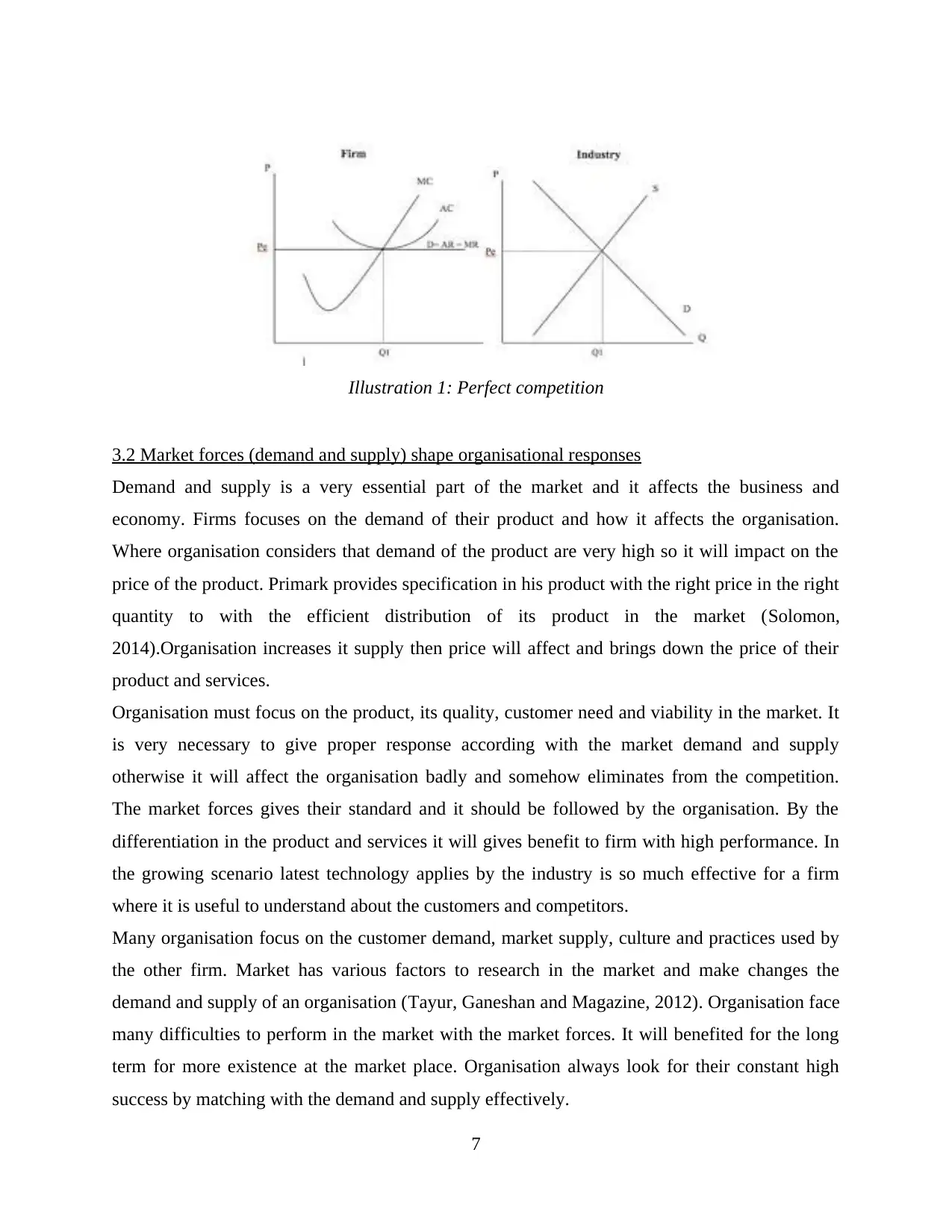
3.2 Market forces (demand and supply) shape organisational responses
Demand and supply is a very essential part of the market and it affects the business and
economy. Firms focuses on the demand of their product and how it affects the organisation.
Where organisation considers that demand of the product are very high so it will impact on the
price of the product. Primark provides specification in his product with the right price in the right
quantity to with the efficient distribution of its product in the market (Solomon,
2014).Organisation increases it supply then price will affect and brings down the price of their
product and services.
Organisation must focus on the product, its quality, customer need and viability in the market. It
is very necessary to give proper response according with the market demand and supply
otherwise it will affect the organisation badly and somehow eliminates from the competition.
The market forces gives their standard and it should be followed by the organisation. By the
differentiation in the product and services it will gives benefit to firm with high performance. In
the growing scenario latest technology applies by the industry is so much effective for a firm
where it is useful to understand about the customers and competitors.
Many organisation focus on the customer demand, market supply, culture and practices used by
the other firm. Market has various factors to research in the market and make changes the
demand and supply of an organisation (Tayur, Ganeshan and Magazine, 2012). Organisation face
many difficulties to perform in the market with the market forces. It will benefited for the long
term for more existence at the market place. Organisation always look for their constant high
success by matching with the demand and supply effectively.
7
Illustration 1: Perfect competition
Demand and supply is a very essential part of the market and it affects the business and
economy. Firms focuses on the demand of their product and how it affects the organisation.
Where organisation considers that demand of the product are very high so it will impact on the
price of the product. Primark provides specification in his product with the right price in the right
quantity to with the efficient distribution of its product in the market (Solomon,
2014).Organisation increases it supply then price will affect and brings down the price of their
product and services.
Organisation must focus on the product, its quality, customer need and viability in the market. It
is very necessary to give proper response according with the market demand and supply
otherwise it will affect the organisation badly and somehow eliminates from the competition.
The market forces gives their standard and it should be followed by the organisation. By the
differentiation in the product and services it will gives benefit to firm with high performance. In
the growing scenario latest technology applies by the industry is so much effective for a firm
where it is useful to understand about the customers and competitors.
Many organisation focus on the customer demand, market supply, culture and practices used by
the other firm. Market has various factors to research in the market and make changes the
demand and supply of an organisation (Tayur, Ganeshan and Magazine, 2012). Organisation face
many difficulties to perform in the market with the market forces. It will benefited for the long
term for more existence at the market place. Organisation always look for their constant high
success by matching with the demand and supply effectively.
7
Illustration 1: Perfect competition
⊘ This is a preview!⊘
Do you want full access?
Subscribe today to unlock all pages.

Trusted by 1+ million students worldwide
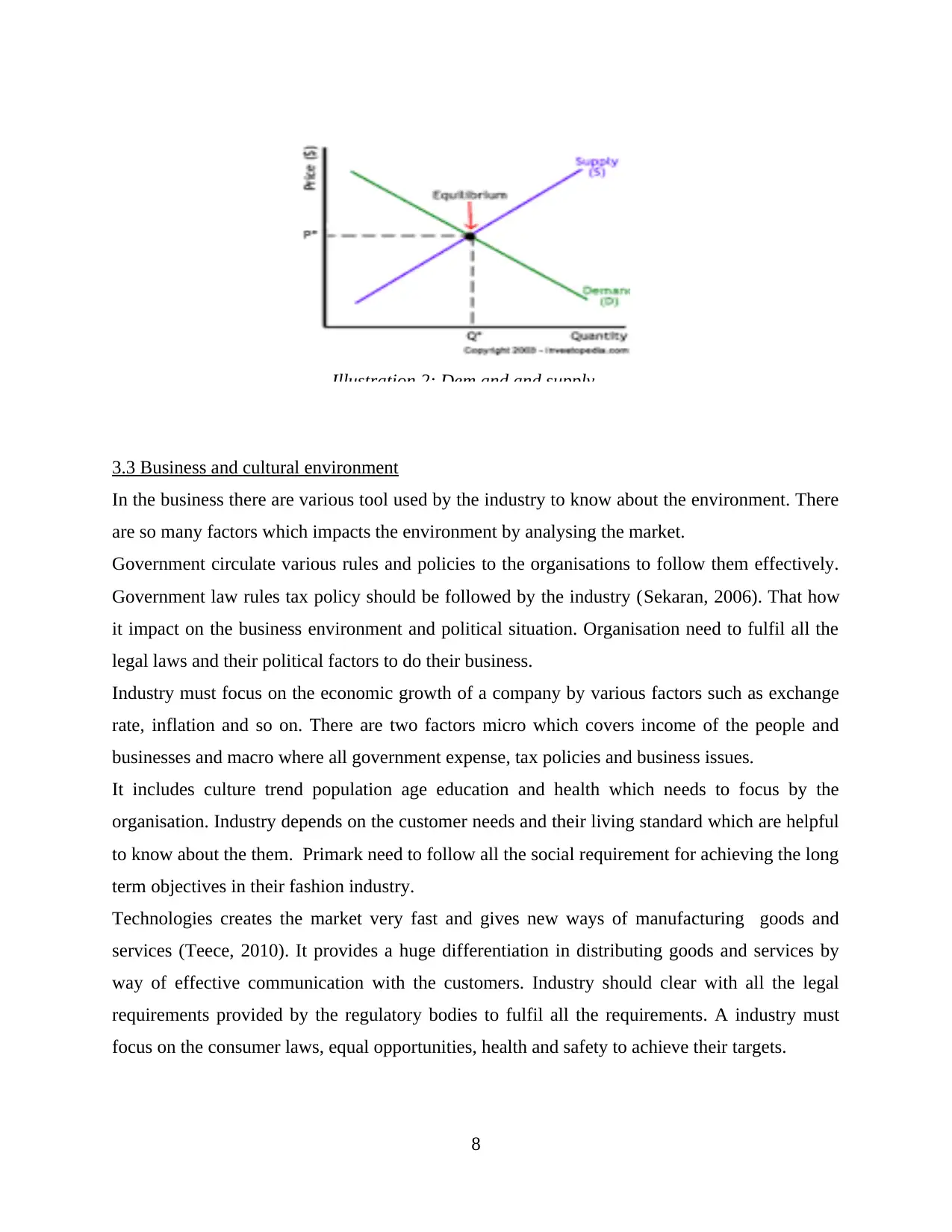
3.3 Business and cultural environment
In the business there are various tool used by the industry to know about the environment. There
are so many factors which impacts the environment by analysing the market.
Government circulate various rules and policies to the organisations to follow them effectively.
Government law rules tax policy should be followed by the industry (Sekaran, 2006). That how
it impact on the business environment and political situation. Organisation need to fulfil all the
legal laws and their political factors to do their business.
Industry must focus on the economic growth of a company by various factors such as exchange
rate, inflation and so on. There are two factors micro which covers income of the people and
businesses and macro where all government expense, tax policies and business issues.
It includes culture trend population age education and health which needs to focus by the
organisation. Industry depends on the customer needs and their living standard which are helpful
to know about the them. Primark need to follow all the social requirement for achieving the long
term objectives in their fashion industry.
Technologies creates the market very fast and gives new ways of manufacturing goods and
services (Teece, 2010). It provides a huge differentiation in distributing goods and services by
way of effective communication with the customers. Industry should clear with all the legal
requirements provided by the regulatory bodies to fulfil all the requirements. A industry must
focus on the consumer laws, equal opportunities, health and safety to achieve their targets.
8
Illustration 2: Dem,and and supply
In the business there are various tool used by the industry to know about the environment. There
are so many factors which impacts the environment by analysing the market.
Government circulate various rules and policies to the organisations to follow them effectively.
Government law rules tax policy should be followed by the industry (Sekaran, 2006). That how
it impact on the business environment and political situation. Organisation need to fulfil all the
legal laws and their political factors to do their business.
Industry must focus on the economic growth of a company by various factors such as exchange
rate, inflation and so on. There are two factors micro which covers income of the people and
businesses and macro where all government expense, tax policies and business issues.
It includes culture trend population age education and health which needs to focus by the
organisation. Industry depends on the customer needs and their living standard which are helpful
to know about the them. Primark need to follow all the social requirement for achieving the long
term objectives in their fashion industry.
Technologies creates the market very fast and gives new ways of manufacturing goods and
services (Teece, 2010). It provides a huge differentiation in distributing goods and services by
way of effective communication with the customers. Industry should clear with all the legal
requirements provided by the regulatory bodies to fulfil all the requirements. A industry must
focus on the consumer laws, equal opportunities, health and safety to achieve their targets.
8
Illustration 2: Dem,and and supply
Paraphrase This Document
Need a fresh take? Get an instant paraphrase of this document with our AI Paraphraser
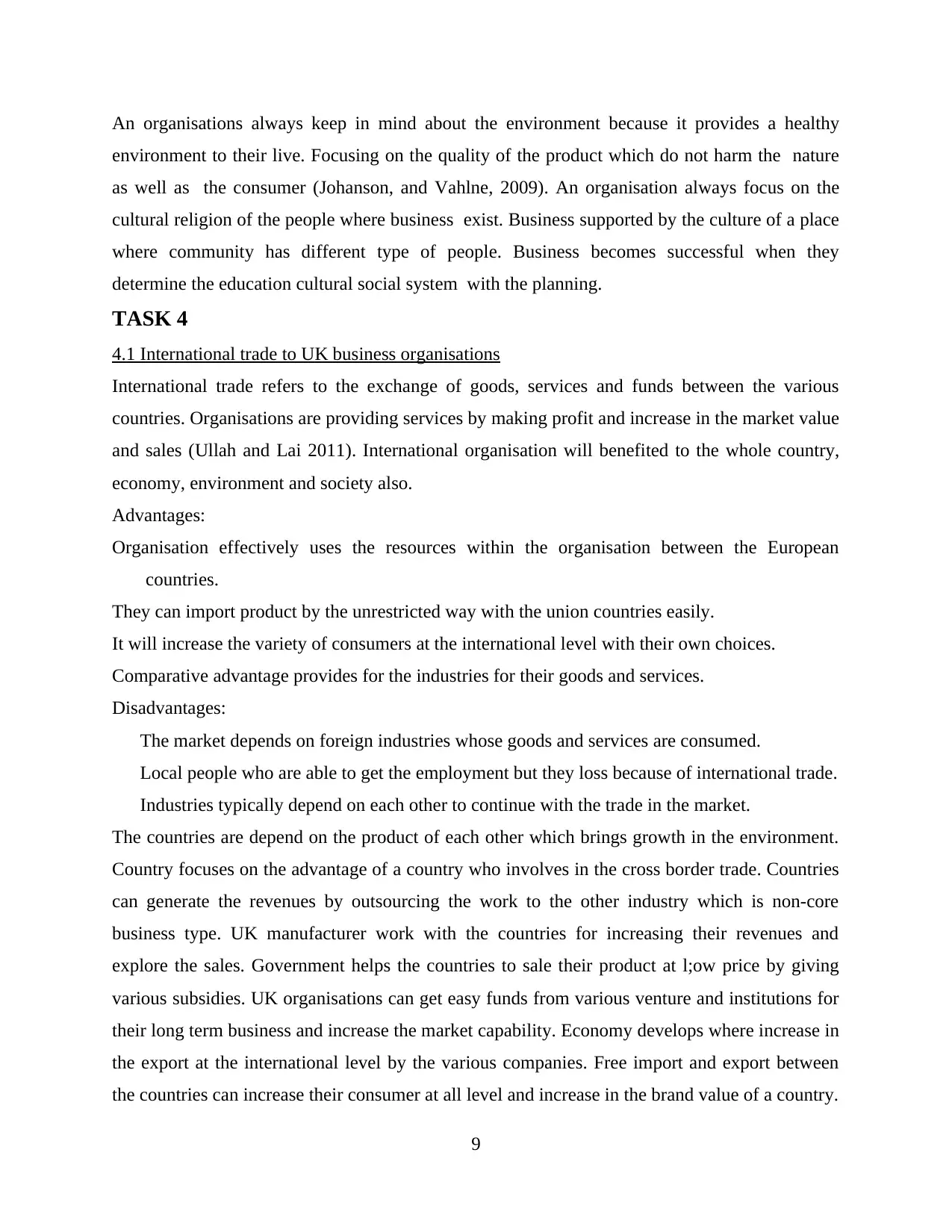
An organisations always keep in mind about the environment because it provides a healthy
environment to their live. Focusing on the quality of the product which do not harm the nature
as well as the consumer (Johanson, and Vahlne, 2009). An organisation always focus on the
cultural religion of the people where business exist. Business supported by the culture of a place
where community has different type of people. Business becomes successful when they
determine the education cultural social system with the planning.
TASK 4
4.1 International trade to UK business organisations
International trade refers to the exchange of goods, services and funds between the various
countries. Organisations are providing services by making profit and increase in the market value
and sales (Ullah and Lai 2011). International organisation will benefited to the whole country,
economy, environment and society also.
Advantages:
Organisation effectively uses the resources within the organisation between the European
countries.
They can import product by the unrestricted way with the union countries easily.
It will increase the variety of consumers at the international level with their own choices.
Comparative advantage provides for the industries for their goods and services.
Disadvantages:
The market depends on foreign industries whose goods and services are consumed.
Local people who are able to get the employment but they loss because of international trade.
Industries typically depend on each other to continue with the trade in the market.
The countries are depend on the product of each other which brings growth in the environment.
Country focuses on the advantage of a country who involves in the cross border trade. Countries
can generate the revenues by outsourcing the work to the other industry which is non-core
business type. UK manufacturer work with the countries for increasing their revenues and
explore the sales. Government helps the countries to sale their product at l;ow price by giving
various subsidies. UK organisations can get easy funds from various venture and institutions for
their long term business and increase the market capability. Economy develops where increase in
the export at the international level by the various companies. Free import and export between
the countries can increase their consumer at all level and increase in the brand value of a country.
9
environment to their live. Focusing on the quality of the product which do not harm the nature
as well as the consumer (Johanson, and Vahlne, 2009). An organisation always focus on the
cultural religion of the people where business exist. Business supported by the culture of a place
where community has different type of people. Business becomes successful when they
determine the education cultural social system with the planning.
TASK 4
4.1 International trade to UK business organisations
International trade refers to the exchange of goods, services and funds between the various
countries. Organisations are providing services by making profit and increase in the market value
and sales (Ullah and Lai 2011). International organisation will benefited to the whole country,
economy, environment and society also.
Advantages:
Organisation effectively uses the resources within the organisation between the European
countries.
They can import product by the unrestricted way with the union countries easily.
It will increase the variety of consumers at the international level with their own choices.
Comparative advantage provides for the industries for their goods and services.
Disadvantages:
The market depends on foreign industries whose goods and services are consumed.
Local people who are able to get the employment but they loss because of international trade.
Industries typically depend on each other to continue with the trade in the market.
The countries are depend on the product of each other which brings growth in the environment.
Country focuses on the advantage of a country who involves in the cross border trade. Countries
can generate the revenues by outsourcing the work to the other industry which is non-core
business type. UK manufacturer work with the countries for increasing their revenues and
explore the sales. Government helps the countries to sale their product at l;ow price by giving
various subsidies. UK organisations can get easy funds from various venture and institutions for
their long term business and increase the market capability. Economy develops where increase in
the export at the international level by the various companies. Free import and export between
the countries can increase their consumer at all level and increase in the brand value of a country.
9
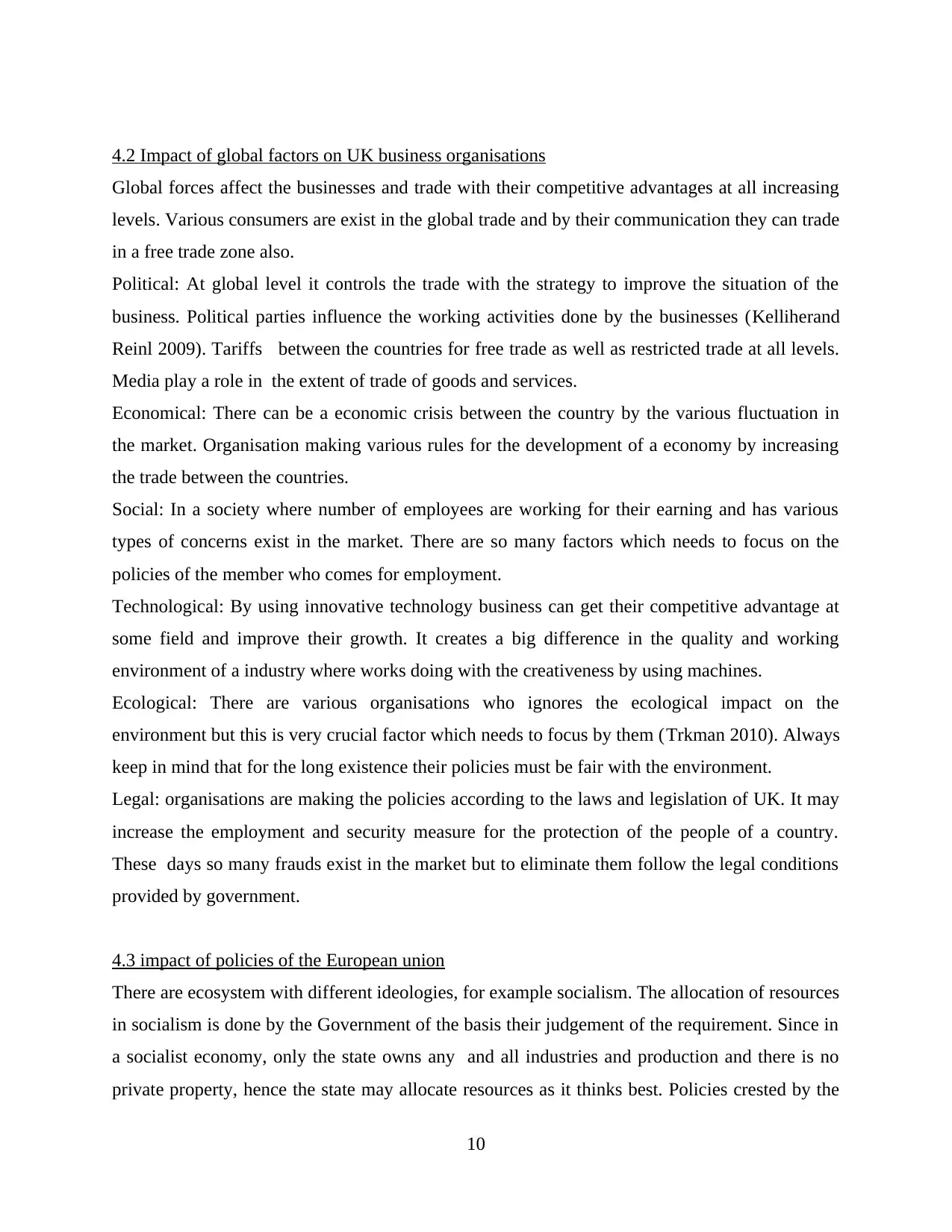
4.2 Impact of global factors on UK business organisations
Global forces affect the businesses and trade with their competitive advantages at all increasing
levels. Various consumers are exist in the global trade and by their communication they can trade
in a free trade zone also.
Political: At global level it controls the trade with the strategy to improve the situation of the
business. Political parties influence the working activities done by the businesses (Kelliherand
Reinl 2009). Tariffs between the countries for free trade as well as restricted trade at all levels.
Media play a role in the extent of trade of goods and services.
Economical: There can be a economic crisis between the country by the various fluctuation in
the market. Organisation making various rules for the development of a economy by increasing
the trade between the countries.
Social: In a society where number of employees are working for their earning and has various
types of concerns exist in the market. There are so many factors which needs to focus on the
policies of the member who comes for employment.
Technological: By using innovative technology business can get their competitive advantage at
some field and improve their growth. It creates a big difference in the quality and working
environment of a industry where works doing with the creativeness by using machines.
Ecological: There are various organisations who ignores the ecological impact on the
environment but this is very crucial factor which needs to focus by them (Trkman 2010). Always
keep in mind that for the long existence their policies must be fair with the environment.
Legal: organisations are making the policies according to the laws and legislation of UK. It may
increase the employment and security measure for the protection of the people of a country.
These days so many frauds exist in the market but to eliminate them follow the legal conditions
provided by government.
4.3 impact of policies of the European union
There are ecosystem with different ideologies, for example socialism. The allocation of resources
in socialism is done by the Government of the basis their judgement of the requirement. Since in
a socialist economy, only the state owns any and all industries and production and there is no
private property, hence the state may allocate resources as it thinks best. Policies crested by the
10
Global forces affect the businesses and trade with their competitive advantages at all increasing
levels. Various consumers are exist in the global trade and by their communication they can trade
in a free trade zone also.
Political: At global level it controls the trade with the strategy to improve the situation of the
business. Political parties influence the working activities done by the businesses (Kelliherand
Reinl 2009). Tariffs between the countries for free trade as well as restricted trade at all levels.
Media play a role in the extent of trade of goods and services.
Economical: There can be a economic crisis between the country by the various fluctuation in
the market. Organisation making various rules for the development of a economy by increasing
the trade between the countries.
Social: In a society where number of employees are working for their earning and has various
types of concerns exist in the market. There are so many factors which needs to focus on the
policies of the member who comes for employment.
Technological: By using innovative technology business can get their competitive advantage at
some field and improve their growth. It creates a big difference in the quality and working
environment of a industry where works doing with the creativeness by using machines.
Ecological: There are various organisations who ignores the ecological impact on the
environment but this is very crucial factor which needs to focus by them (Trkman 2010). Always
keep in mind that for the long existence their policies must be fair with the environment.
Legal: organisations are making the policies according to the laws and legislation of UK. It may
increase the employment and security measure for the protection of the people of a country.
These days so many frauds exist in the market but to eliminate them follow the legal conditions
provided by government.
4.3 impact of policies of the European union
There are ecosystem with different ideologies, for example socialism. The allocation of resources
in socialism is done by the Government of the basis their judgement of the requirement. Since in
a socialist economy, only the state owns any and all industries and production and there is no
private property, hence the state may allocate resources as it thinks best. Policies crested by the
10
⊘ This is a preview!⊘
Do you want full access?
Subscribe today to unlock all pages.

Trusted by 1+ million students worldwide
1 out of 16
Related Documents
Your All-in-One AI-Powered Toolkit for Academic Success.
+13062052269
info@desklib.com
Available 24*7 on WhatsApp / Email
![[object Object]](/_next/static/media/star-bottom.7253800d.svg)
Unlock your academic potential
Copyright © 2020–2025 A2Z Services. All Rights Reserved. Developed and managed by ZUCOL.





